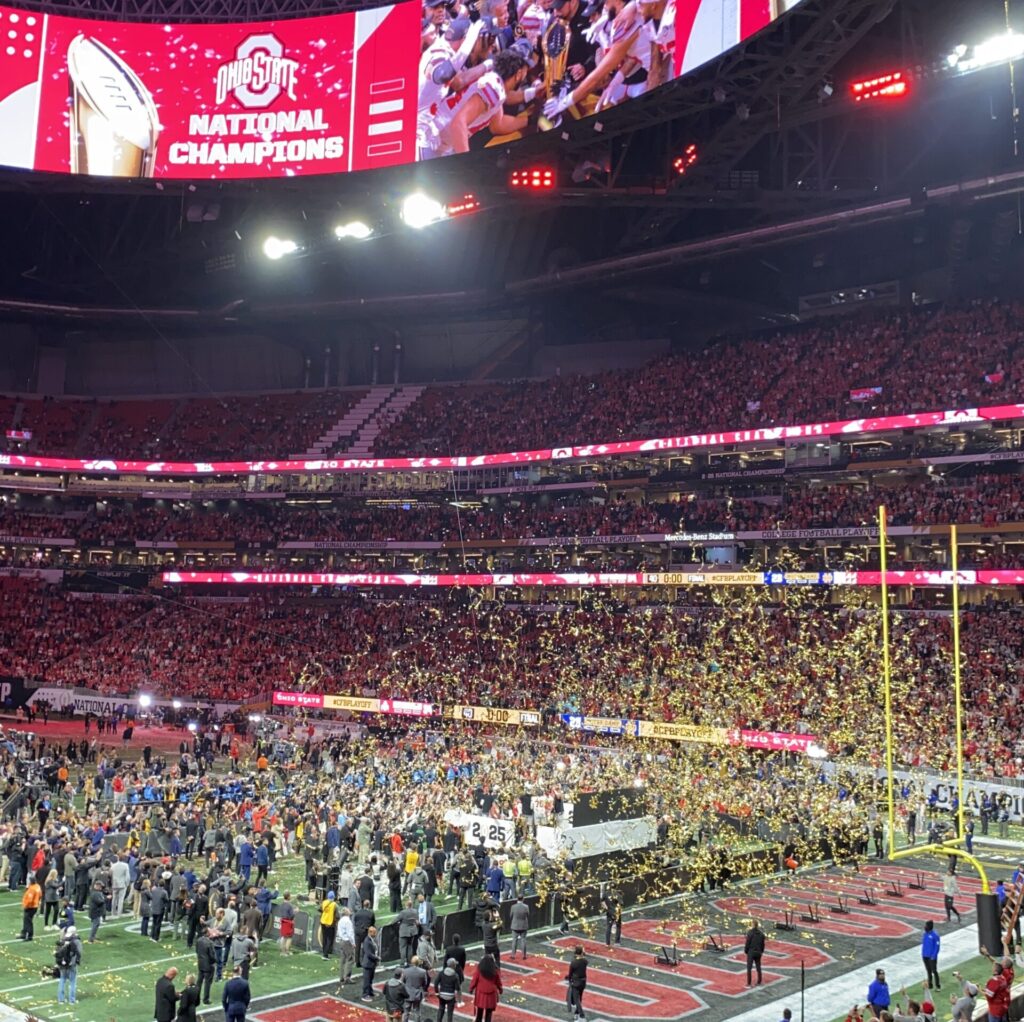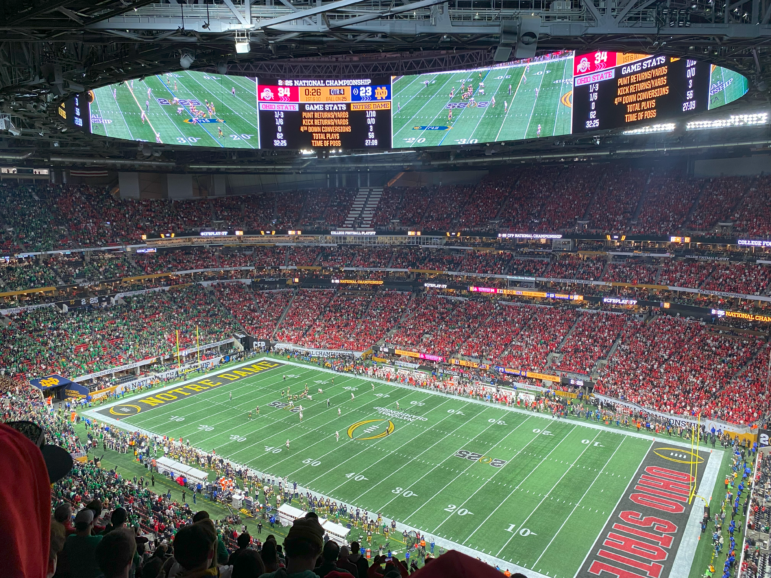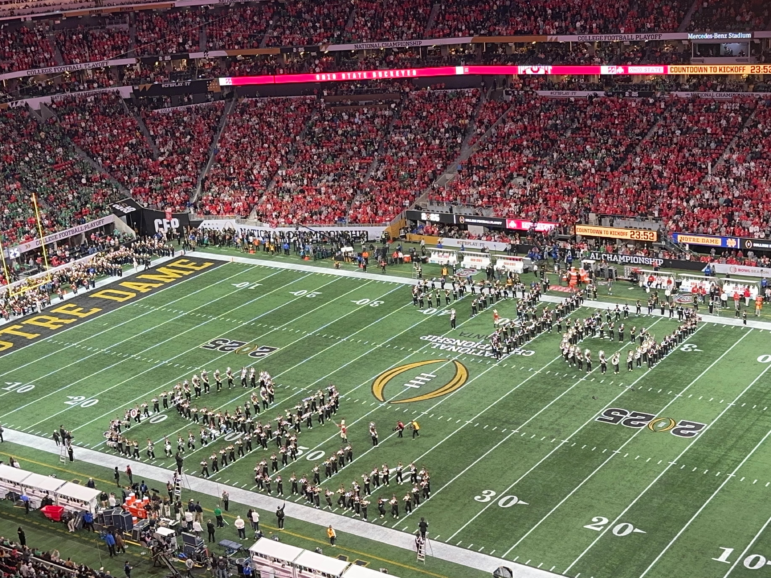
On Jan. 20th, the eighth-seeded Ohio State Buckeyes (13-2) clinched the 2025 college football national championship by winning 34-23 against the seventh-seeded Notre Dame Fighting Irish.
The Buckeyes won their last national title at the end of the 2014 season, in the first year of the four-team playoff. Their latest championship comes during the inaugural 12-team playoff.
Before the title game, Ohio State defeated the 9th-seeded Tennessee, followed by the first-seeded Oregon and the fifth-seeded Texas. Ohio State lost to Oregon earlier in the season, with the playoffs giving them a way to avenge that loss. The Irish defeated the 10th-seeded Indiana in the first round, followed by the second-seeded Georgia and the sixth-seeded Penn State.
The new twelve-team playoff format became the subject of critics. Many questioned the automatic bye given to the four conference champions, pointing out that all four of the teams with a bye lost.
“All the teams that got the bye [week], they all lost,” said senior Ian Chang. “I don’t think it’s a good system, but I think they’re going to change it.”
Others commented on how the bye week might take away the edge that the higher-ranked teams have.
“The best way to practice is in-game, you can’t practice for actual game day conditions,” said sophomore Alexander Hernandez. “So by giving these teams a bye, they were set up for failure.”
In addition to the conference champions being eliminated, many critics were concerned with the amount of blowouts.
“I feel like they should take into consideration the strength of schedule,” Hernandez said. “More [Associated Press] rank wins, stronger opponents. You can have a good undefeated record, but if it’s against weaker opponents that doesn’t really equate to a nine and three record of AP ranked teams.”

Both Ohio State and Notre Dame played impressively in the championship game. In a dominant first drive, Notre Dame went for 75 yards in 18 plays, converting two fourth downs. One key player was Riley Leonard, Notre Dame’s quarterback, with nine carries and a rushing touchdown in the first drive.
“Ohio State’s defense was getting exposed on Notre Dame’s opening drive because they ran the same thing on both fourth downs and Ohio State still couldn’t stop it,” said sophomore Taylor Workman. “Having nine carries in a single drive as a quarterback is crazy.”
Following Notre Dame’s opening touchdown, Ohio State scored three touchdowns on three consecutive drives, with two receiving touchdowns by Jeremiah Smith and Quinshon Judkins and a rushing touchdown by Judkins to finish off the half.
One notable player in the first half of Ohio State’s offense was their quarterback, Will Howard. He completed 13 consecutive passes in the first half, setting a record for the national championship game.
“I think he completed 14 out of 15 passes in the first half, which is really hard to do as a quarterback, especially in a national championship game,” said junior Javier Del Rio. “He hasn’t really had the opportunity to throw the ball much until the playoffs, where the pressure was all on him, and he did really well.”
The Buckeyes continued their momentum in the second half, scoring on the opening drive with Judkins’ 70-yard run and rushing touchdown, bringing the score up to 28-7.
In the next drive, the Irish turned over the ball on downs after a fake punt that ended in an incomplete pass. The Buckeyes were stopped short of a touchdown on this drive, settling for a field goal to bring the lead up to 31-7.

On Notre Dame’s next possession, Jaden Greathouse scored a 34-yard receiving touchdown. Following Greathouse’s touchdown, the Irish converted for two points, reducing the gap to 16 points.
“Greathouse really got their momentum going with the touchdown in the second half,” Workman said. “Their offense was making explosive plays and Ohio State’s defense was struggling to stop it.”
The Buckeyes continued to struggle scoring touchdowns after the opening drive in the second half with wide receiver Emeka Egbuka fumbling the ball around Notre Dame’s 20-yard line. This allowed Notre Dame to gain the ball back, however they came up with no score after a missed field goal on fourth and goal at the 9-yard line with about nine-and-a-half minutes left in the game. This left the Irish in a 16-point deficit.
“They should have gone for it because that was their only chance,” Chang said. “The missed field goal was the final nail in the coffin for Notre Dame.”
Ohio State was forced to punt on their possession, allowing the Irish to have the ball back. Greathouse scored again, this time a 30-yard receiving touchdown. The Irish went for two and got it, bringing the score to 31-23.
The Buckeyes bounced back however, with Will Howard completing a 56-yard pass to Jeremiah Smith on third-and-11, who was brought down around Notre Dame’s 10-yard line. Smith’s catch secured the win for the Buckeyes with around two minutes left in the game, allowing them to make a field goal and widen their lead to 11 points with around 30 seconds left.
While it may need some reformatting to make it more fair, the expansion of the playoffs allows for a wider variety of champions that truly reflects the best team in college football.
In the 2025 season, teams like Ohio State and Georgia look to face significant losses with seniors graduating and athletes entering the transfer portal. However, they are still expected to be main contenders for a national title next year, along with teams like Texas, Penn State, Notre Dame and Oregon.



